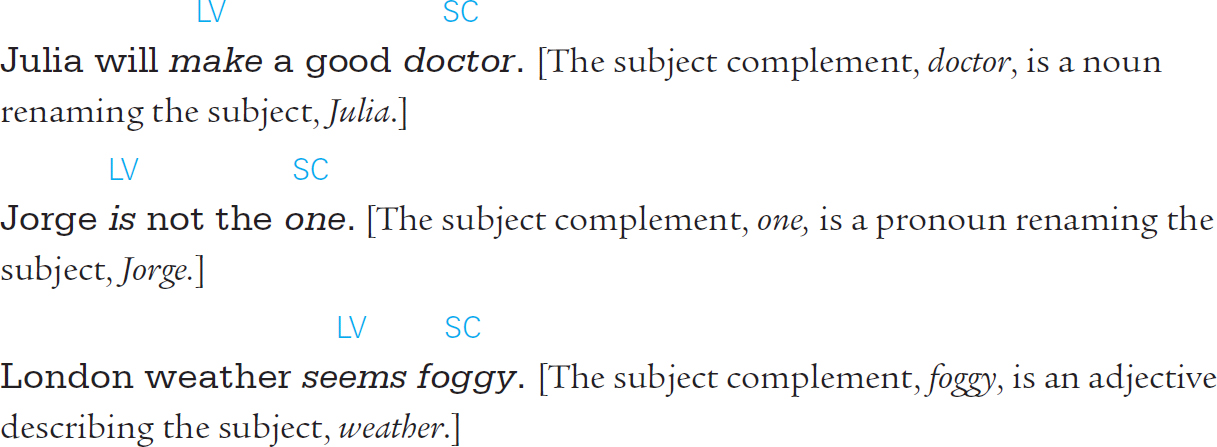3 | Verbs, Objects, and Complements
3|Verbs, Objects, and Complements
Verbs provide information about the subject’s action or state of being. Action verbs show action (swim, eat, sleep), and linking verbs (is, become, seem, feel) link the subject of a sentence with a word that renames or describes it. A few verbs accompany a main verb to add information about time or possibility; they are called helping or auxiliary verbs (have, must, can).
3aAction Verbs and Objects
Most action verbs (AV) can be followed by one or more objects. A direct object (DO) is the target of the verb’s action. It usually answers the question What? or Who?

An indirect object (IO) is the recipient of the verb’s action. It usually answers the question For what? or For whom?

Some verbs, known as transitive verbs, require an object in order to make their meaning clear.

 Guidelines for Multilingual Writers
Guidelines for Multilingual Writers
Do I Use the Preposition to or for with Indirect Objects?
These sentences mean the same thing:
I sent the president a letter.
I sent a letter to the president.
In the first sentence, the president is the indirect object: he or she receives the direct object (a letter), which was acted on (sent) by the subject of the sentence (I). In the second sentence, the same idea is expressed using a prepositional phrase beginning with to.
Some verbs can use either an indirect object or the preposition to: give, send, lend, offer, owe, pay, sell, show, teach, tell. Some verbs can use an indirect object or the preposition for: bake, build, buy, cook, find, get, make.
I paid the travel agent one hundred dollars.
I paid one hundred dollars to the travel agent.
Margarita cooked her family some chicken.
Margarita cooked some chicken for her family.
Page 743Some verbs cannot have an indirect object; they must use a preposition. The following verbs must use the preposition to: describe, demonstrate, explain, introduce, and suggest.

The following verbs must use the preposition for: answer and prepare.

Some verbs must have an indirect object; they cannot use a preposition. The following verbs must have an indirect object: ask and cost.

3bLinking Verbs and Complements
A linking verb (LV) shows what the subject of a sentence is or is like. The linking verb connects the subject with its subject complement (SC)—a noun, a pronoun, or an adjective.
 Common Linking Verbs at a Glance
Common Linking Verbs at a Glance
Some linking verbs tell what a noun is, was, or will be.
be, become, remain: I remain optimistic.
grow: The sky is growing dark.
make: One plus two makes three.
prove: His warning proved accurate.
turn: The weather turned cold.
Some linking verbs tell what a noun might be.
appear, seem, look: The child looks cold.
Most verbs of the senses can operate as linking verbs.
feel, smell, sound, taste: The smoothie tastes sweet.

A verb may be a linking verb in some sentences and a transitive verb in others. If you focus on what the verb means, you can usually tell how it is functioning.

Object complements are similar to subject complements in that they rename a noun, in this case the object of a verb or preposition. But no linking verb is required with object complements.

3cHelping Verbs
Verbs such as have, must, and can that accompany a main verb to add information about its action are called helping or auxiliary verbs. Adding a helping or auxiliary verb to a main verb allows you to express a wide variety of tenses and moods. (See 8.) The parts of this combination, called a verb phrase, need not appear together and may be separated by other words.

 Helping Verbs at a Glance
Helping Verbs at a Glance
Of the twenty-three helping verbs, fourteen can also act as main verbs that identify the central action.
be, is, am, are, was, were, being, been
do, does, did
have, has, had
The other nine act only as helping verbs, never as main verbs. As modals, they show actions that are possible, doubtful, necessary, required, and so on.
can, could, should, would, may, might, must, shall, will
EXERCISE 3-1 Identifying Verbs, Objects, and Complements
Label the underlined word or word group in the following sentences as action verb (AV), linking verb (LV), helping verb (HV), main verb (MV), direct object (DO), indirect object (IO), or subject complement (SC). Example:
An entrepreneur named Percy Shaw invented reflectors for road signs after seeing a cat’s eyes glowing in his headlights on a foggy night.
An inventor named George de Mestral noticed burrs in his dog’s fur; he then gave the world Velcro.
Many scientists are eager to discover new products.
Accidents have also inspired inventions.
A machine giving off microwave particles melted a chocolate bar, leading to the invention of the microwave oven.
Soda and other sugary beverages are at least partly responsible for increasing obesity rates in children.
Some schools sell children soft drinks, which nutritionists say is a bad idea.
Milk is more important than sugary drinks for developing bones.
Some cities and states have passed laws to tax sodas.
Others want extra-large sodas to be completely banned.
Learning by Doing Finding Subjects and Verbs
Learning by Doing Finding Subjects and Verbs
Finding Subjects and Verbs
Being able to identify subjects and verbs in your own writing will make it much easier to find and fix common grammatical problems such as subject-verb agreement errors. Working from a draft of a current or previous assignment, underline all the main subjects you can find, and double underline all the main verbs you can find. Draw a line connecting the subject-verb pairs. Do some subjects have more than one verb? Do some verbs have more than one subject? Do some sentences have multiple subject-verb pairs? All these situations are acceptable if the correct grammar and punctuation are used.